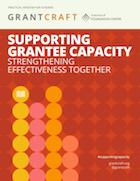Site Search
- resource provided by the Forum Network Knowledgebase.
Search Tip: Search with " " to find exact matches.


In Supporting Grantee Capacity: Strengthening Effectiveness Together, GrantCraft looks at how funders approach building capacity with grantees. Through examples from foundations ranging in size, mission, and geography, we explore various strategies for capacity building and the types of awareness that funders can choose to incorporate in decision making to facilitate informed, thoughtful judgments about strengthening organizations.
Much has changed since For Momentum’s first survey of corporate decision makers. They have found, across the board, that stakeholders have higher expectations of companies and their cause platforms. Consumers want companies to step up. Nonprofits need company support to build awareness and raise funds. And now, more than ever before, the C-suite sees CSR as a must-have strategy. But how are the corporate partnership decision makers reacting to these increased pressures? For Momentum polled seasoned corporate partner pros to learn more about their partnership perspectives. Their feedback, summarized in this report, provides timely, data-driven insights and comparative analysis to help cause practitioners navigate complexity in the social impact marketplace and set strategy to create next level partnerships.
Johnson & Johnson extends our sympathy and support to the thousands of people affected by the devastating earthquakes in Turkey and Syria.
In the immediate aftermath of this disaster, we have been assisting the region by:
- Pledging $1 million for disaster relief efforts to support the following NGOs: International Medical Corps (IMC) and International Rescue Committee (IRC).
- Donating funds to Direct Relief for immediate support of the rescue efforts on the ground in Turkey.
- Donating thermal blankets and working to provide other items in urgent need, including hygiene products, surgical sutures, hemostats, wound closures, and other medical products.
- Establishing an employee giving campaign that is supported with matched gifts for global engagement.
- Supporting temporary accommodation, transportation and access to food and water to impacted employees and their immediate families.
The Community FoodBank of New Jersey, the state’s largest anti-hunger and anti-poverty organization, has received a $100,000 grant from Bank of America, it announced Wednesday.
The grant will provide general operating support for the organization, which aims to end food insecurity in a state where nearly 1 million people are food-insecure, including more than 260,000 children.
CFBNJ serves 15 of the state’s 21 counties through food distribution and support services.
“We are immensely grateful for Bank of America’s longtime support and for this generous grant that helps to fund our mission,” Elizabeth McCarthy, CEO and president of CFBNJ, said in a prepared statement. “We appreciate Bank of America’s continued investment in building a food-secure future.”
The New Jersey Historic Trust, an affiliate of the New Jersey Department of Community Affairs (DCA), today approved a total of $16,598,738 in grant recommendations from the Preserve New Jersey Historic Preservation Fund to save and promote historic sites throughout the state. Seventy-five preservation planning, municipal, county, and regional planning, heritage tourism, and capital projects are included in this year’s list of recommendations.
“Historic preservation is an integral part of community and economic revitalization and I am excited to see a diverse list of grant recipients this year,” said DCA Commissioner Jacquelyn A. Suárez. “From historic homes, farms, schoolhouses, and churches to train stations, lighthouses, and villages, the work that will be accomplished with the preservation grants will help to secure the future of our most treasured historic places in the Garden State.”
This research brief summarizes early findings from a survey commissioned by Enterprise Community Partners, Inc. to measure the ongoing impact of Hurricane Sandy, one year after the storm made landfall. Based on a representative sample of households in New York, Connecticut and New Jersey, this survey provides crucial insight into the long-term needs of those affected by the storm.
